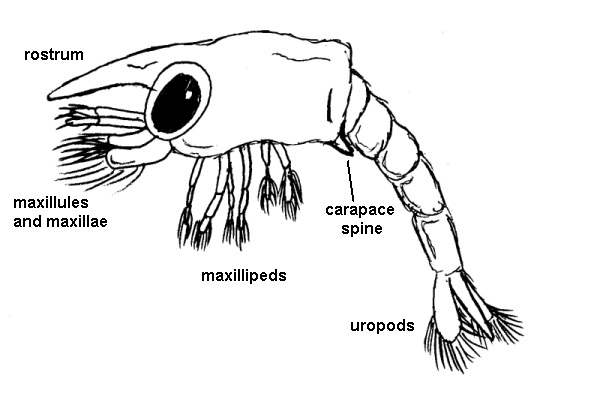Development
Rearing and scientific description of Dardanus larvae in laboratory conditions has not received much attention (Hebling and Barras Mansur 1995) and no records can be found for Dardanus megistos. While precise characters of larvae can vary as in adults (Bartilotti et al. 2008), the general form remains conserved across genera, family and in the case of hermit crabs is largely similar to that of a generalised anomuran (McLaughlin et al. 2004).

|
| A megalopa stage hermit crab, most likely similar to but not taken from observation of D. megistos. Illustration by Storm Martin 2012, adapted with modification from Forest et al. 2000
|
As with most other anomurans and also brachyurans, the larvae hatching from hermit crab eggs are referred to as zoea (McLaughlin et al. 2004, Ruppert et al. 2004). Zoea are free swimming and show most of the segments typifying the malacostracan body plan from this early stage; one abdominal segment is missing (McLaughlin et al. 2004). Anomuran zoea have a protective carapace, as with the adult form, however unlike adult hermit crabs, the rostrum or anterior carapace spine is pronounced (Hebling and Barras Mansur 1995) and apparently provides some protection against predation by small fish (Ruppert et al. 2004). A pair of posterior lateral carapace spines are also present in many anomurans, including those of Paguridae (McLaughlin et al. 2004), but not apparently of Diogenidae (Hebling and Barras Mansur 1995, Bartilotti et al. 2008). Anomuran zoea also exhibit all cephalothoracic appendages except the posterior most maxillipeds (3rd maxilliped pair) in many cases. They may however lack the remaining thoracic and abdominal appendages (McLaughlin et al. 2004). A telson is also usually present and the abdomen is elongated (McLaughlin et al. 2004) and, in hermit crabs, not yet coiled.
Larvae pass through multiple zoeal stages before metamorphosing into what is known as the megalopa. In another diogenid from a different genus, Clibanarius aequabilis, Bartilotti et al. (2008) recorded four zoeal stages, metamorphosing after eight days. However, Dardanus insignis from Brazil recorded eight stages (Hebling and Barras Mansur 1995). Morphology changes progressively over zoeal molts; the missing abdominal segment arises and the uropods, pereopods and pleopod buds form. At which stage these characters arise varies between species. In C. aequabilis, the missing abdominal segment appears in the third zoeal stage, a pair of uropods, five of the six pleopods (as buds) and all pereopods are present from the first zoeal stage (Bartilotti et al. 2008). In D. insignis, uropods appear at the third stage, pleopods do not appear until the final (eighth) stage and pereopods are absent until after metamorphosis (Hebling and Barras Mansur 1995). Without further information available, D.megistos must be presumed to have a longer zoeal period but with less development of appendages as in D. insignis.
Zoea are planktotrophic, the maxillipeds are used for swimming and the mandibles and maxillules for feeding (McLaughlin et al. 2004). Following metamorphosis, the megalopa takes on a benthic lifestyle; the pereopods develop for walking and the maxillipeds now become associated with feeding (McLaughlin et al. 2004). While the megalopa looks to have all the features of an adult, in hermit crabs, the abdomen is not yet coiled and remains calcified. Following the megalopa stage is another metamorphosis into the first juvenile instar, of which there may be several. The megalopa must find a shell before or soon after metamorphosis as the juvenile form exhibits the coiled, soft abdomen. Metamorphosis can be delayed up to at least twelve days in some species if a shell cannot be found (Harms 1992).

|
|
A zoeal stage hermit crab larvae, most likely similar to but not taken from observation of D. megistos. Illustration by Storm Martin 2012, adapted with modification from Forest et al. 2000
|
|